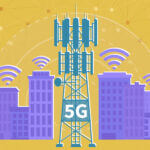
5G is finally here. This year, we’ve seen the first 5G networks going live for consumers in the US, UK and South Korea. It’s the first generation of cellular network technology designed with IoT applications in mind and will make a big difference in the medium to long-term. But, for anyone planning an IoT project right now, what are 5G’s benefits – and is it truly a viable option?
The Advantages of 5G for IoT
It’s worth noting that some of the big advantages of 5G for consumer applications – the higher connection speeds and greater capacity – aren’t of much relevance for IoT, which typically uses a large number of devices, each sending a small amount of data. The extra capacity could theoretically be a boon to IoT because it allows for a much greater density of devices within a region, but in truth, it’s very rare to find a Applications today where the density is too high for existing networks.
The biggest gain lies in its lower power usage. When we say 5G was built with the IoT in mind, this is what we mean. Previous cellular technology was designed on the assumption that it would be used predominantly by mobile phones with batteries which are charged once a day, and each generation has consumed more power than the last. But 5G is much better optimized for devices sending small amounts of data, reducing the overhead of signaling and payload for any particular bit of data.
The benefits of lower power consumption – either smaller batteries or longer battery life – are huge for IoT and connected devices. Smaller devices allow for greater flexibility in how an IoT solution is deployed, while extended life means devices can be left in the field for longer without requiring costly maintenance.
Alternatives to 5G
However, while 5G has now started to roll out, it’s unlikely to be ready for most IoT Applications today. The networks are still geographically limited, and you also have to consider the availability of 5G-compatible devices and all of the systems integration steps that come along with that.
In truth, waiting for 5G could mean waiting for a significant time. And there are other solutions available right now that can solve most of the same IoT problems.
The most notable is LoRa, a low-power wide-area network (LPWAN) technology based on an unlicensed public spectrum which was first developed in 2009 but has started to see widespread adoption in the past 12-18 months. It’s specifically designed to send very small amounts of data with very low overhead.
There are limitations, of course. A LoRa module gives around 10 kilometers of coverage in open space, which confines it to Applications with static devices operating in a fixed area. Public LoRa networks also exist, but these only cover major urban areas unlike cellular networks, where a device can reliably connect in almost any city on earth.
Whether it’s the right technology depends on the specific requirements of your Applications, including location, bandwidth and security. Alternatively, your needs may be better served by using current cellular technology and accepting larger batteries in the short term or by some combination of technologies.
The vast majority of IoT applications are viable on currently available technology. Implement it correctly, and you’ll be ready to transition to 5G once its coverage is more ubiquitous and hardware is more affordable.
To learn more about 5G and other IoT connectivity options that can interconnect everyone, everything, everywhere, read “Managing IoT Connectivity for Tomorrow: Growing your connected device business” and join the SAP Digital Interconnect Community.
Written by Mirko Benetti, VP, Head of Sales EMEA and APJ, SAP Digital Interconnect and John Candish, Head of IoT Products, SAP Digital Interconnect.





 New Episode
New Episode





 Latest IoT News
Latest IoT News








